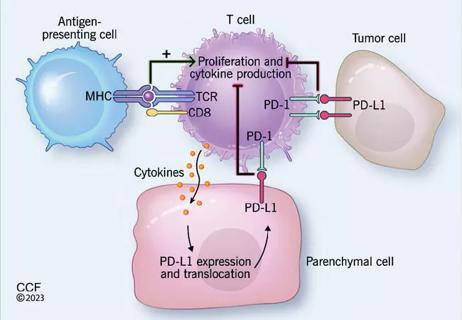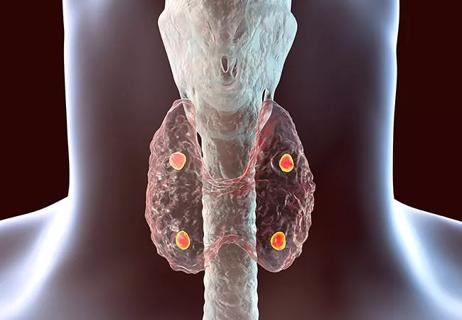Practicing value-based care

By Alexandra Mikhael, MD, and Christian Nasr, MD
Cleveland Clinic is a non-profit academic medical center. Advertising on our site helps support our mission. We do not endorse non-Cleveland Clinic products or services. Policy
Chest X-ray (CXR) prior to thyroid surgery continues to be routinely obtained at some institutions despite the lack of evidence for its utility. Because unnecessary testing would be adding medical, financial and personal expenses without benefit, physicians at the Cleveland Clinic Endocrinology & Metabolism Institute aimed to determine if obtaining a CXR before thyroidectomy is clinically useful.
The practice of ordering a CXR before surgery originally stemmed in the 1940s when it was done to identify asymptomatic tuberculosis carriers and evolved thereafter to routine pre-operative testing to identify underlying disease and to help in postoperative care. This practice first began to be questioned in the 1970s, and some studies have since been conducted in an attempt to establish proper criteria for testing. To try to determine whether obtaining a CXR impacted perioperative management, we investigated whether difficult intubation or cancer stage correlated with CXR abnormalities.
This study retrospectively looked at 594 consecutive patients who underwent thyroidectomy at Cleveland Clinic from January 2004 to December 2009. Those without a CXR were excluded from the study. Data were collected including demographics, CXR findings, anesthesia records, pathologic data including cancer stage and the presence of metastases. Of the 594 patients, 494 had a pre-operative CXR (Fig.1). Seventy-three percent had cancer on pathology and 16 percent had evidence of distant metastases.

The most common abnormality was rib or other skeletal abnormality, which occurred in 25.3 percent of all chest X-rays, followed by tracheal deviation 16 percent, cardiomegaly 12 percent, lung nodules (6 percent, of which 3 percent were subcentimetric and 0.5 percent showing diffuse nodularity), emphysema 2 percent and pleural effusion 1 percent. Of 78 patients (15.8 percent) with tracheal deviation on CXR, only 5 percent had a difficult intubation during surgery. CXR was shown to impact management in 4 percent, i.e., 100 preoperative CXRs would need to be performed in order to alter the course of management in only four cases.
Notably, patients without a cancer diagnosis on surgical pathology were more likely to have tracheal deviation than patients with cancer. However, among patients with cancer, the incidence of tracheal deviation was higher in those with a higher T-stage; in other words, the larger the tumor, the higher the likelihood of tracheal deviation.
In assessing for the presence of metastases, it was observed that non-metastatic cancers were more likely to have CXR abnormalities than metastatic cancers. Furthermore, while evaluating the two major CXR abnormalities that would be clinically relevant in patients with malignancy, i.e., the presence of lung nodules and tracheal deviation, there was no significant difference in metastatic versus non-metastatic cancers, meaning that obtaining a CXR was of no added diagnostic benefit.
When deciding to perform any medical procedure, one must weigh the risks versus the benefits to justify the necessity of the procedure. Although obtaining a CXR is a relatively harmless procedure, it does expose patients to a minimal amount of radiation and imposes added cost without an apparent added benefit. Our study showed that obtaining a CXR was not predictive of perioperative complications and the presence of abnormalities did not correlate with increased likelihood of cancer.
We therefore concluded that the utility of preoperative CXR in patients undergoing thyroidectomy, including for thyroid cancer, is very limited. In the climate of value-based care, routine use of this test may be considered redundant and should be ordered only if otherwise clinically indicated.
Dr. Mikhael is a third-year resident in Internal Medicine. Dr. Nasr is a staff physician in the Department of Endocrinology.

Incidence, outcomes and management

Cleveland Clinic endocrinologists work to identify protocols for improving care

Cleveland Clinic’s Endocrinology & Metabolism Institute is working to offer novel opportunities and therapies for diabetes and kidney disease

New findings indicate the importance of achieving sufficient sleep levels in regard to personal glucose targets

A recent study evaluates the correlation between preoperative calcium and parathyroid hormone values as predictors of gland volume and multi-gland disease

A look at how to asses hCG elevation

As the diet’s popularity rises, certain considerations need to be taken when recommending it for patients with Type 1 diabetes

Findings suggest that the effectiveness of interventions may depend more on the frequency and delivery methods of the intervention rather than who is delivering the intervention